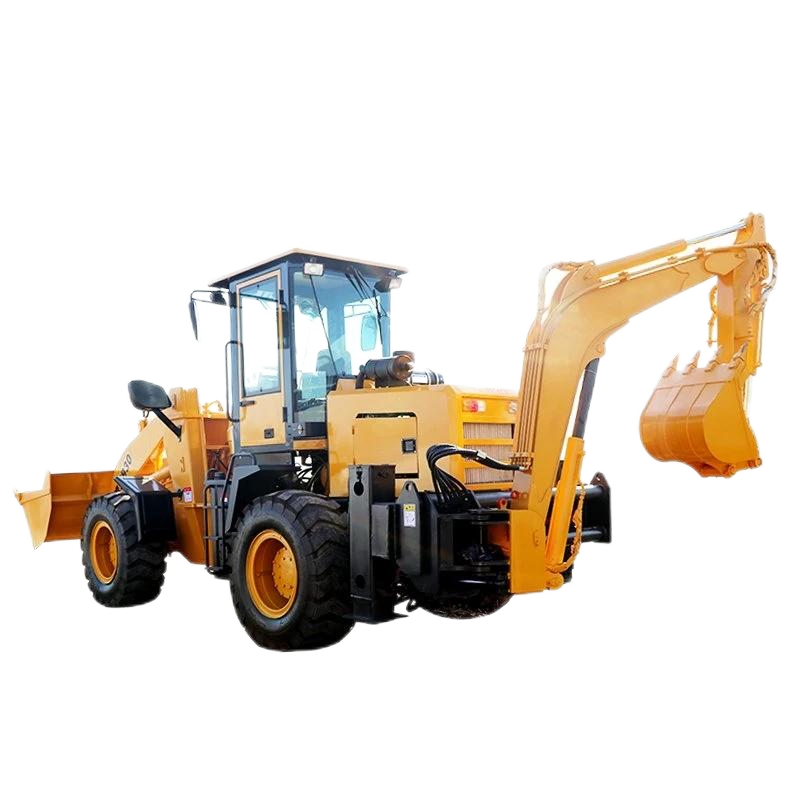The backhoe loader (also known as "two-way machine") is a multi-functional engineering machinery that integrates excavation and loading functions, and is widely used in construction, agriculture, municipal administration, mining and other fields. Its advantages are mainly reflected in multiple aspects such as function integration, operation efficiency and adaptability, as follows:

1. Function integration, one machine with multiple uses
The core advantage of the backhoe loader is that it integrates the functions of an excavator and a loader into one device. It can complete a variety of operations by flexibly switching working devices (such as buckets, excavating arms, breakers, forklift attachments, etc.):
- Excavation operation: excavating soil, sand, construction waste, etc.;
- Loading operation: transporting bulk materials (such as sand, chemical fertilizers, grain);
- Auxiliary operation: combined with attachments, it can realize functions such as bulldozing, lifting, crushing, drilling, cleaning, etc.
This "one machine with multiple functions" feature reduces the cost of equipment purchase and maintenance, and is especially suitable for small and medium-sized projects or scenarios with limited space (such as rural construction, small construction sites).
2. Flexible operation and adaptability to complex environments
- Compact size: Compared with separate excavators and loaders, backhoe loaders have a smaller body and a small turning radius, which can operate flexibly in narrow spaces (such as indoors, roadways, rural roads) without frequent adjustment of equipment positions.
- Convenient movement: It is equipped with its own walking system (wheel-type or crawler-type), which can transfer short distances independently without relying on trailer transportation, saving transfer time and cost.
- Strong terrain adaptability: wheel-type is suitable for hardened roads, and crawler-type is suitable for muddy and soft ground, which can cope with various complex working conditions.
3. Improve operation efficiency
- Reduce equipment switching time: In the same operation cycle (such as "excavation - loading - transportation"), there is no need to replace equipment, and the working device can be switched directly through operation, which greatly shortens the time for process connection.
- Single-person operation can complete multiple tasks: one operator can control both excavation and loading functions at the same time, reducing labor costs and avoiding communication errors in multi-person collaboration.
- Suitable for the "one-stop" needs of small and medium-sized projects: For scenarios with small project volume but diverse processes (such as rural homestead leveling, small municipal maintenance), there is no need to rent multiple devices, reducing the overall construction cost.
4. Significant cost advantage
- The purchase cost is lower than that of two separate devices: The price of one backhoe loader is usually lower than the sum of one excavator and one loader, with less initial investment.
- Low maintenance cost: It shares core components such as power system and chassis, reducing the number of wearing parts and the frequency of maintenance, so the long-term use cost is more economical.
- Less space occupation: Only the space for one device is needed when parking, saving storage or construction site stacking space.
5. Low operation threshold
Although the functions are complex, modern backhoe loaders are generally equipped with intelligent operating systems (such as hydraulic power assistance, integrated control of operating handles). Operators can master basic skills after short-term training, without the need to have professional operating experience in both excavators and loaders, which reduces the cost of human training.
Summary
The core advantages of backhoe loaders lie in function integration, flexibility, efficiency and cost economy. They are especially suitable for small and medium-sized projects and multi-process operation scenarios. They can not only meet diversified construction needs, but also improve overall efficiency by reducing equipment and labor input. They are ideal engineering machinery that combines practicality and economy.





